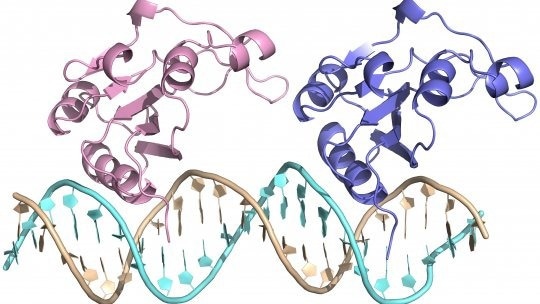All living organisms require DNA replication to ensure the genetic integrity of the following generation. On the other hand, bacteria have the ability to horizontally transfer genetic information to other bacteria. Antibiotic resistance plasmids are found in many pathogenic bacteria, and they are frequently replicated using rolling circle replication machinery.
 Molecular structure of the RepB protein bound to DNA. Image Credit: Institute for Research in Biomedicine
Molecular structure of the RepB protein bound to DNA. Image Credit: Institute for Research in Biomedicine
This group includes the plasmid pMV158, which is found in the genus Streptococcus. The RepB protein initiates replication of this plasmid, which determines tetracycline resistance.
Researchers headed by Dr Miquel Coll from the Institute for Research in Biomedicine (IRB Barcelona) and the Institute of Molecular Biology of Barcelona (IBMB-CSIC), and Dr Gloria del Solar at the Center for Biological Research (CIB-CSIC), discovered a new hexameric structure of the RepB protein and how it binds to DNA.
Biochemical and X-Ray crystallography techniques were used in the research. This structure indicates a high degree of flexibility, which is attributed to this protein’s ability to perform a dual function, namely, to attach to two distinct positions of the plasmid and cut one of the DNA strands to separate it, thereby initiating replication.
In general, few resources are devoted to the development of new antibiotics and greater efforts should be made in this regard. It’s also crucial to determine how resistance to antibiotics occurs and how it’s propagated. This plasmid is also promiscuous, meaning that it is transferred between different bacterial species and, as a result, resistance to the antibiotic spreads.”
Dr Miquel Coll, Head, Structural Biology of Protein and Nucleic Acid Complexes and Molecular Machines Lab, Institute for Research in Biomedicine
Dr Miquel Coll is also a Professor at the CSIC.
A growing medical concern
Antibiotics are medicines that, since their discovery, have saved millions of lives. However, their widespread use has resulted in the evolution of resistance and the rapid spread of bacteria bearing plasmids containing resistance genes. These resistant bacteria have become a major problem, particularly in hospitals where many antibiotics are used and vulnerable patients are present.
The massive use of antibiotics, both in humans and livestock, has led to growing resistance to them. Nosocomial infections, that is, those that occur in hospitals and that the patient did not have when admitted, affect 7% of patients and are difficult to treat due to the current resistance to antibiotics.”
Dr Miquel Coll, Head, Structural Biology of Protein and Nucleic Acid Complexes and Molecular Machines Lab, Institute for Research in Biomedicine
Source:
Journal reference:
Machón, C., et al. (2023) Structures of pMV158 replication initiator RepB with and without DNA reveal a flexible dual-function protein. Nucleic Acids Research. doi.org/10.1093/nar/gkac1271.